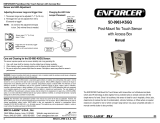ENFORCER Wave-to-Open Sensors FAQ
Page 2 SECO-LARM U.S.A., Inc.
Is it possible to use this sensor as an anti-theft sensor, triggering when an object is removed from the
sensor’s read range instead when an object enters the sensors read range?
Yes, though one of our stand-alone sensors (CS-PDxxx-Series) might be a better option. To serve as an anti-theft sensor,
use the sensor’s N.C. output (green) instead of the N.O. output. Connect this to the alarm panel’s N.C. input and the COM
(blue) to the alarm panel’s COM terminal.
Can I connect the sensors directly to a door strike?
Yes, but we suggest connecting a metal oxide varistor (MOV) or diode (both not included) as close as possible and in
parallel with the controlled output device. Make sure that the diode’s cathode (striped end) is installed toward the strike’s
positive terminal. This absorbs possible electromagnetic interference to prevent damaging the IR proximity sensor. See
manual for further details.
Are these sensors weatherproof?
Yes, when properly installed. Only the front is IP65 weatherproof (except the SD-9773-KNEVQ, which is IP54). The back
side must be protected from any possible water entry. For the plate models, use a waterproof back box and apply a bead
of silicone sealant (not included) around the rim of the backbox and the faceplate edge and a small amount beneath each
screw head. The SD-9773-KNEVQ should not be installed where it may receive spray from below, such as from a lawn
sprinkler.
What is the purpose of the manual override button on some models?
The manual override button allows for operation if the sensor is disabled for some reason.
General Installation Questions
I have a sensor installed outdoors and it sometimes triggers unexpectedly. What could be the problem?
Due to the nature of IR technology, an IR sensor can be triggered by a direct light source such as sunlight, reflected light
from a shiny object, or other direct light aimed at the sensor. If you install outdoors, consider any possible sources of
reflected or direct light and how that may be avoided. Consider a hood or some other shield to protect the sensor from
such a light source.
My sensor remains triggered. What could be causing that?
To ensure proper operation, make sure no objects sit or come within 113/4" (30cm) and within a cone of 60° to the left and
right of the front of the IR proximity sensor to avoid interference.
Reduce the IR range of the sensor (see Can I adjust the sensor’s triggering range?).
Ensure that your sensor’s output duration is not adjusted to maximum. Turning the trimpot to maximum will set the trigger
to toggle mode (see Can I adjust the trigger duration?).
Check that the power supply’s voltage is correct (12~24 VDC).
My sensor will not trigger. What could be causing that?
Increase the IR range of the sensor (see Can I adjust the sensor’s triggering range?).
Check that the power supply’s voltage is correct (12~24 VDC).
How should I clean the sensor?
The sensor requires special care to ensure reliability and a long operating life. When cleaning is needed: 1) Use a soft,
clean cloth (a microfiber cloth is recommended) and use the mildest cleaner available. 2) Spray the cleaning solution onto
the cleaning cloth instead of the unit. 3) Wipe any excess liquid from the sensor. Wet spots may affect the sensor's
performance and leave a dust ring when they dry.





